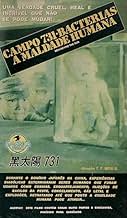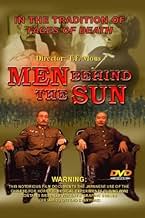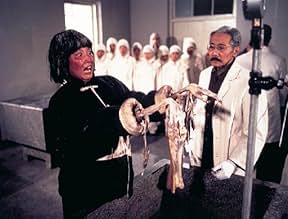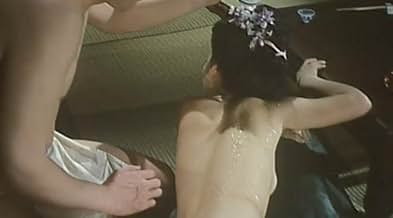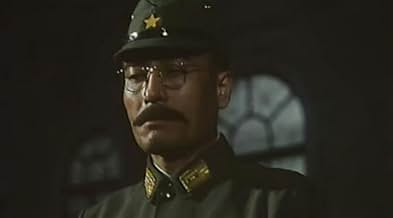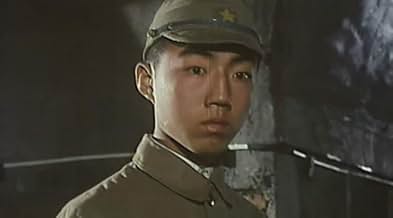IMDb रेटिंग
6.1/10
7.8 हज़ार
आपकी रेटिंग
अपनी भाषा में प्लॉट जोड़ेंJapanese troops round up Chinese and Russian prisoners of war and take them to unit 731, where they're horribly tortured and experimented on to test new biological weapons.Japanese troops round up Chinese and Russian prisoners of war and take them to unit 731, where they're horribly tortured and experimented on to test new biological weapons.Japanese troops round up Chinese and Russian prisoners of war and take them to unit 731, where they're horribly tortured and experimented on to test new biological weapons.
Zhaohua Mei
- Takamura
- (as Zhao Hua Mei)
Runshen Wang
- Camp Lieutenant
- (as Run Shen Wang)
फ़ीचर्ड समीक्षाएं
Watching 'Men Behind The Sun' is a very odd experience, because it's difficult to tell what exactly it is trying to achieve. On the surface it is presented as a supposedly serious expose of some of the little known war crimes committed by the Japanese in WW2. But it is made in such a trashy way (compounded by the badly dubbed copy I watched) that it comes across closer to an 'Ilsa, She-Wolf Of The SS' exploitation movie, minus the sex.
The reason this movie is so notorious is mainly because of a handful of scenes. One sequence, the frostbite experiment, is shocking, but obviously special effects, so gorehounds will treat it like a Romero or Fulci gore scene. However, two others, the autopsy scene, and the decompression chamber scene, appear to use real corpses. These are gruesome but strangely fascinating. What really pushes this movie over the edge though are the two scenes which involve animal abuse. One is very short but involves a horde of fleeing rats being burned alive. This scene is obviously real. The other is the notorious segment which involves a cat being eaten alive by rats. This appears to be real, and if it is, it's the most reprehensible thing I've ever seen in a movie. If it is faked it is one of the most convincing special effects I've ever watched, and even so, the cat is obviously highly distressed.
I must admit I still don't know what to think about this movie. If the film makers genuinely intended this to be a serious look at Japanese atrocities I would applaud it for bringing to attention a disgusting series of events that should not be forgotten. However, as I am dubious about their sincerity, I remain nonplussed. I can't really get all high and mighty about it, because after all I did watch the thing, and therefore I would feel like a hypocrite for having done so. All I can say is that if you want to see an extreme piece of film making and are not easily disturbed, 'Men Behind The Sun' is truly unforgettable.
The reason this movie is so notorious is mainly because of a handful of scenes. One sequence, the frostbite experiment, is shocking, but obviously special effects, so gorehounds will treat it like a Romero or Fulci gore scene. However, two others, the autopsy scene, and the decompression chamber scene, appear to use real corpses. These are gruesome but strangely fascinating. What really pushes this movie over the edge though are the two scenes which involve animal abuse. One is very short but involves a horde of fleeing rats being burned alive. This scene is obviously real. The other is the notorious segment which involves a cat being eaten alive by rats. This appears to be real, and if it is, it's the most reprehensible thing I've ever seen in a movie. If it is faked it is one of the most convincing special effects I've ever watched, and even so, the cat is obviously highly distressed.
I must admit I still don't know what to think about this movie. If the film makers genuinely intended this to be a serious look at Japanese atrocities I would applaud it for bringing to attention a disgusting series of events that should not be forgotten. However, as I am dubious about their sincerity, I remain nonplussed. I can't really get all high and mighty about it, because after all I did watch the thing, and therefore I would feel like a hypocrite for having done so. All I can say is that if you want to see an extreme piece of film making and are not easily disturbed, 'Men Behind The Sun' is truly unforgettable.
Men Behind the Sun deals with the torture of Chinese POWs by their Japanese captors: Air Squadron 731, at the latter's snow-bound concentration camp.
I've seen a lot of extreme cinema in my time: not because I'm a "gorehound" or am constantly seeking the "ultimate nasty" but because I want a film to affect me. I'm very much of the "it's just a film" school and it therefore takes a well-made, strong film in order to allow me to suspend my disbelief.
I've seen most of the so-called "nasties", including Cannibal Holocaust and some of the Guinea Pig series. I didn't find the latter terribly effective and Cannibal holocaust is a gut-munching gore fest in its uncut form but Men Behind the Sun completely eclipses it for sheer brutality.
What makes Men Behind the Sun so effective for me is the relative realism. Zombie movies don't disturb me simply because zombies are fantasy. To a lesser extent, so are cannibals. Both genres have "yuck" moments and on first viewing, Cannibal Holocaust shocked me slightly with its relentless gore. Men Behind the Sun is somehow more calculated.
Why am I making comparisons with Cannibal Holocaust? The majority of film viewers will be familiar with the so-called "video nasties" and will probably have seen some of them. Cannibal Holocaust is generally considered to be the strongest of the video nasties but Men Behind the Sun is in a different league, in my opinion. Men Behind the Sun is to Cannibal Holocaust as Cannibal Holocaust is to say, The Exorcist.
What makes Men Behind the Sun so effective is its realism: humans, not zombies, cannibals or monsters. It deals with what atrocities humans are capable of committing upon their own kind.
Guinea Pig: The Devil's Experiment is a similar study but it has all characterisation and plot stripped away, leaving just the torture. Because of this, there are no characters to engage or empathise with. Certain scenes are very graphic but without context and therefore not affecting.
Men Behind the Sun has characters and plot and most of the film is just that: a film. The torture and experiment scenes are intense sequences set within what is otherwise a normal film. And there lies the film's effectiveness: because it builds characters, we are drawn in. Because the film deals with real life, we are able to suspend our disbelief and become immersed in it.
The torture and experiment scenes in Men Behind the Sun are intense for their unstinting focus and graphic depiction of cruelty. They are disturbing but compelling; like looking at a car crash when you know you shouldn't. The imagery is so graphic and realistic that the scenes stay with you, long after viewing the film.
*** Possible spoilers ***
Even before the gory torture and experiment scenes, we witness utter inhumanity near the beginning of the film, as a mother is robbed of her baby. A Japanese officer simply takes the baby from the mother and tosses it into the snow. As the mother weeps, the officer muffles the baby's cries by kicking snow over it.
Later in the film, we see the mother tied to a wooden structure in the freezing outdoors. An officer approaches her, treading on her baby's body as he does so. Her already frost-bitten arms are doused in cold water several times, before she's taken inside. There, her arms are dipped in a solution of some kind and I shan't describe what follows. To do so would deny any potential viewer one of the biggest shocks of the film. Be prepared.
Continuing the frostbite theme, we see a Chinese man forced to place his arms into a dry ice container. They emerge frozen solid and are then hacked off by a Japanese soldier, breaking like china.
The infamous decompression chamber sequence is where the director is alleged to have used a real cadaver. I can't confirm or deny that but the scene is another shocking one: a Chinese man is placed inside the chamber and the pressure gradually reduced. Eventually, the pressure is so little that the man's colon falls out of his anus.
Another notorious scene is the live autopsy: a deaf, mute Chinese boy, whom the viewer grows to like, is tricked into lying on an operating trolley. There he is anaesthetised with ether before being dissected. Rumours abound that this scene also used a real cadaver but personally I doubt that. I am convinced from the camera cuts that this sequence is just very good special effects. Once done with the boy, the Japanese simply throw his crumpled body into a trailer before he's taken away for incineration: completely inhuman and affecting.
The sequence involving the cat is the one probably most often thought to be real. I can't be absolutely sure but I don't believe this to be the case. Rather, I believe that the cat could have been drugged and certainly think the blood to be fake. In any case, the cat being eaten alive by rats is a very disturbing scene.
*** End of spoilers ***
Overall, this is a strong piece of film-making, in every sense. The story is a worthy one and the unpleasant imagery serves to drive home the message that the film carries. These are not images that are easily erased from one's mind. This film certainly affected me.
I would recommend this film as advised viewing. I wouldn't say to anyone, "If you want to see something really nasty...", or "You have to see this film because it's really gory." Rather, I would advise watching it, with caution and preparedness for what lies within, as a good, powerful film.
This film will stay with me for a long time: savage, powerful and unforgettable
I've seen a lot of extreme cinema in my time: not because I'm a "gorehound" or am constantly seeking the "ultimate nasty" but because I want a film to affect me. I'm very much of the "it's just a film" school and it therefore takes a well-made, strong film in order to allow me to suspend my disbelief.
I've seen most of the so-called "nasties", including Cannibal Holocaust and some of the Guinea Pig series. I didn't find the latter terribly effective and Cannibal holocaust is a gut-munching gore fest in its uncut form but Men Behind the Sun completely eclipses it for sheer brutality.
What makes Men Behind the Sun so effective for me is the relative realism. Zombie movies don't disturb me simply because zombies are fantasy. To a lesser extent, so are cannibals. Both genres have "yuck" moments and on first viewing, Cannibal Holocaust shocked me slightly with its relentless gore. Men Behind the Sun is somehow more calculated.
Why am I making comparisons with Cannibal Holocaust? The majority of film viewers will be familiar with the so-called "video nasties" and will probably have seen some of them. Cannibal Holocaust is generally considered to be the strongest of the video nasties but Men Behind the Sun is in a different league, in my opinion. Men Behind the Sun is to Cannibal Holocaust as Cannibal Holocaust is to say, The Exorcist.
What makes Men Behind the Sun so effective is its realism: humans, not zombies, cannibals or monsters. It deals with what atrocities humans are capable of committing upon their own kind.
Guinea Pig: The Devil's Experiment is a similar study but it has all characterisation and plot stripped away, leaving just the torture. Because of this, there are no characters to engage or empathise with. Certain scenes are very graphic but without context and therefore not affecting.
Men Behind the Sun has characters and plot and most of the film is just that: a film. The torture and experiment scenes are intense sequences set within what is otherwise a normal film. And there lies the film's effectiveness: because it builds characters, we are drawn in. Because the film deals with real life, we are able to suspend our disbelief and become immersed in it.
The torture and experiment scenes in Men Behind the Sun are intense for their unstinting focus and graphic depiction of cruelty. They are disturbing but compelling; like looking at a car crash when you know you shouldn't. The imagery is so graphic and realistic that the scenes stay with you, long after viewing the film.
*** Possible spoilers ***
Even before the gory torture and experiment scenes, we witness utter inhumanity near the beginning of the film, as a mother is robbed of her baby. A Japanese officer simply takes the baby from the mother and tosses it into the snow. As the mother weeps, the officer muffles the baby's cries by kicking snow over it.
Later in the film, we see the mother tied to a wooden structure in the freezing outdoors. An officer approaches her, treading on her baby's body as he does so. Her already frost-bitten arms are doused in cold water several times, before she's taken inside. There, her arms are dipped in a solution of some kind and I shan't describe what follows. To do so would deny any potential viewer one of the biggest shocks of the film. Be prepared.
Continuing the frostbite theme, we see a Chinese man forced to place his arms into a dry ice container. They emerge frozen solid and are then hacked off by a Japanese soldier, breaking like china.
The infamous decompression chamber sequence is where the director is alleged to have used a real cadaver. I can't confirm or deny that but the scene is another shocking one: a Chinese man is placed inside the chamber and the pressure gradually reduced. Eventually, the pressure is so little that the man's colon falls out of his anus.
Another notorious scene is the live autopsy: a deaf, mute Chinese boy, whom the viewer grows to like, is tricked into lying on an operating trolley. There he is anaesthetised with ether before being dissected. Rumours abound that this scene also used a real cadaver but personally I doubt that. I am convinced from the camera cuts that this sequence is just very good special effects. Once done with the boy, the Japanese simply throw his crumpled body into a trailer before he's taken away for incineration: completely inhuman and affecting.
The sequence involving the cat is the one probably most often thought to be real. I can't be absolutely sure but I don't believe this to be the case. Rather, I believe that the cat could have been drugged and certainly think the blood to be fake. In any case, the cat being eaten alive by rats is a very disturbing scene.
*** End of spoilers ***
Overall, this is a strong piece of film-making, in every sense. The story is a worthy one and the unpleasant imagery serves to drive home the message that the film carries. These are not images that are easily erased from one's mind. This film certainly affected me.
I would recommend this film as advised viewing. I wouldn't say to anyone, "If you want to see something really nasty...", or "You have to see this film because it's really gory." Rather, I would advise watching it, with caution and preparedness for what lies within, as a good, powerful film.
This film will stay with me for a long time: savage, powerful and unforgettable
Please do not watch this movie only for its gory scenes. There aren ´t that many of them and you can see similar ones regularly on Reality TV and the likes. The film´s true driving force is strong acting, good script and the veil of foulness, for the story (and even the gore scenes) are based on true facts and documents. You will certainly be disturbed, but rather for the feeling that what you´re watching really happened. Definetly recommended. 7/10
This is one of THE most disturbing movies I've seen. The thing that disturbed me the most was that it was based on the events of Squadron 731. The human testing in the movie was well done and pretty realistic. Some scenes were campy, while others made you wanna get up and vomit. The most disgusting to me was the cat thrown in a room of thousands of hungry rats. The rats tore the cat apart, and it was with real a real cat and real rats! No effects! Nonetheless, it was a good movie with a good story. Definitely don't plan to watch this movie with the family (or the cat) after Sunday dinner.
I saw this for the first time recently n got disturbed badly.
I cudnt sleep or do my workout.
This movie is not supposed to be enjoyed nor shud be viewed for entertainment values. It shud be only seen for sheer enlightening.
The autopsy of an alive child made me lose hope in humanity. The gruesome experiment in the decompression chamber took away my sleep n appetite.
The most shocking aspect is why wud anyone protect a monster like Shiro Ishii. For scientific data?
This movie is not supposed to be enjoyed nor shud be viewed for entertainment values. It shud be only seen for sheer enlightening.
The autopsy of an alive child made me lose hope in humanity. The gruesome experiment in the decompression chamber took away my sleep n appetite.
The most shocking aspect is why wud anyone protect a monster like Shiro Ishii. For scientific data?
क्या आपको पता है
- ट्रिवियाDirector Tun-Fei Mou paid a lot of attention to the film's historical accuracy and sought to create something that very earnestly captured his true-life source material doing years of research. He chose actors who purposely resembled Japanese people of the war era and even cast Korean kids living in China to play the Youth Corp as Mou thought Koreans most resembled Japanese kids of that era. Mou filmed the movie in Harbin, Manchuria where 731 was stationed. He used 731's real headquarters as a location, it was a school at the time of the shoot. When Mou took down the school's name and put the Japanese flag back, it horrified the local elderly who had lived through the war. One particularly upset old lady approached Mou and his crew and said "I knew they'd be back (the Japanese), I just hoped it wouldn't be this soon!"
- गूफ़Surgeons cut the stomach of an alive boy without any bleeding.
- भाव
Dr. Shiro Ishii: A small rat can beat a cat. Fleas and germs can defeat bombers and guns. This is... the basic theory behind Squadron 731. It is also my philosophy.
- इसके अलावा अन्य वर्जनThe UK version was cut by 2 minutes by the BBFC to remove a scene where a cat is thrown into a room full of live rats and then killed by them, and to edit shots of rats on fire. Despite the film's graphic violence it received no further BBFC cuts, possibly because the video was given a limited UK release and sold only through Chinese video stores.
- कनेक्शनEdited into Hei tai yang 731 si wang lie che (1994)
टॉप पसंद
रेटिंग देने के लिए साइन-इन करें और वैयक्तिकृत सुझावों के लिए वॉचलिस्ट करें
- How long is Man Behind the Sun?Alexa द्वारा संचालित
विवरण
इस पेज में योगदान दें
किसी बदलाव का सुझाव दें या अनुपलब्ध कॉन्टेंट जोड़ें

![Trailer [OV]](https://m.media-amazon.com/images/M/MV5BNzc1ZjYwZmItOTQ3Yy00NjBkLWE2OGYtMDJkZTU0M2UwYzEwXkEyXkFqcGdeQWxiaWFtb250._V1_QL75_UX500_CR0)
